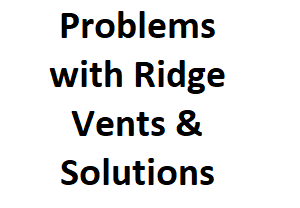Ridge vents are an essential component of roofing systems, designed to provide passive ventilation and improve the overall efficiency of a building. They offer several advantages over traditional roof vents, such as a more discreet appearance and better ventilation performance. However, like any roofing element, ridge vents can experience their fair share of issues over time. In this blog post, we will explore some common problems associated with ridge vents and discuss effective solutions to tackle them.
Improper Installation
One of the most prevalent issues with ridge vents is improper installation. Whether it’s due to rushed work or lack of expertise, a poorly installed ridge vent can lead to significant problems down the line. Common installation errors include improper vent sizing, insufficient fastening, and inadequate sealing.
Tackling the Problem:
To avoid this problem, it’s crucial to hire experienced and reputable roofing contractors for the installation. Professionals will ensure the ridge vent is properly sized and correctly secured to the roof. Additionally, proper sealing techniques using weather-resistant materials will prevent water leaks and potential damage to the roof structure.
Inadequate Ventilation
Believe it or not, ridge vents can sometimes fail to deliver adequate ventilation. Factors such as underperforming intake vents, obstructions, or insufficient ridge vent length can hinder the proper airflow within the attic space. When ventilation is inadequate, it can lead to moisture buildup, mold growth, and decreased energy efficiency.
Tackling the Problem:
To tackle inadequate ventilation, consider installing additional intake vents, such as soffit vents or gable vents. Properly placed intake vents will create a balanced airflow with the ridge vent, ensuring efficient air exchange within the attic. Moreover, regularly inspect and clear any obstructions or debris that might hinder the airflow through the ridge vent.
Animal Infestations
Ridge vents, like other roof components, can become attractive entry points for small animals seeking shelter. Birds, squirrels, and raccoons can create nests or burrows in the vent, obstructing the airflow and causing damage to the roof structure.
Tackling the Problem:
To prevent animal infestations, install ridge vent guards or screens. These specially designed accessories allow proper airflow while keeping animals out. Periodically inspect and clean the ridge vent to ensure no nests or debris have accumulated.
Snow and Rain Infiltration
Ridge vents are susceptible to snow and rain infiltration, especially during heavy storms. If not adequately protected or sealed, moisture can penetrate the attic, leading to water damage, mold growth, and compromised insulation.
Tackling the Problem:
Ensure the ridge vent is installed with a weather-resistant underlayment and a properly sealed ridge cap. Additionally, using a rain diverter above the vent can help redirect water away during heavy rainfall. Regularly inspect the ridge vent’s condition after storms and replace damaged or worn-out parts promptly.
Conclusion
Ridge vents play a crucial role in maintaining a well-ventilated and energy-efficient roofing system. By understanding the potential problems associated with ridge vents and implementing the suggested solutions, homeowners can mitigate these issues effectively. Regular maintenance and periodic inspections are key to ensuring that ridge vents continue to function optimally, protecting the home from moisture-related problems and prolonging the roof’s lifespan. If you encounter any significant issues with your ridge vent, it’s always best to consult with a professional roofing contractor to assess and address the problem adequately.
